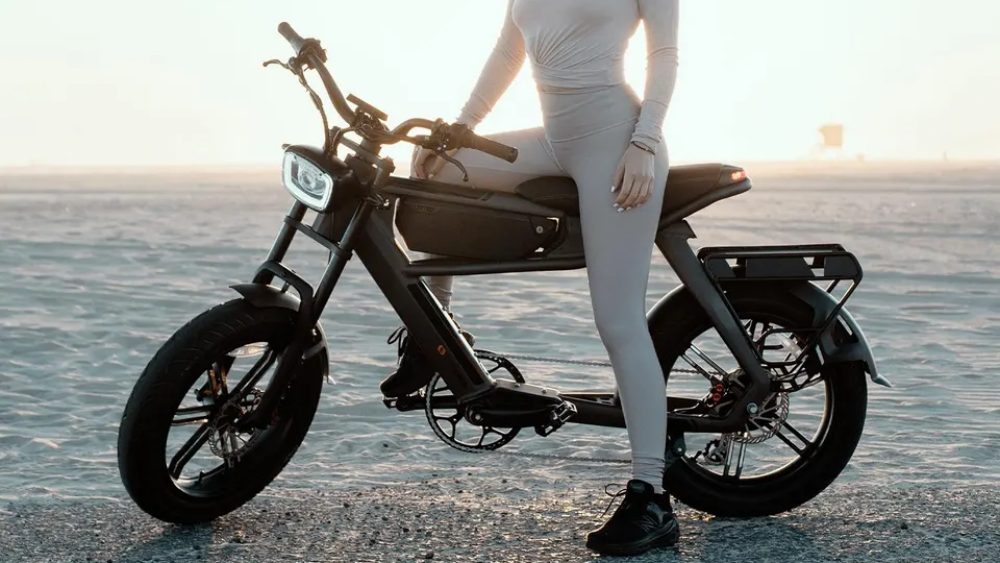Belt drive vs. chain: which is best for ebike?
For over a century, the accepted method of driving a electric bicycle has been through a chain. The pedals drive the chain, which uses a sprocket system to transfer power to the rear wheel. Simple.
But modern bikes, especially electric bike, are reinventing the wheel. Not literally, obviously – the wheel is perfect. While the chain, which has served millions of people well for decades of use, has many advantages, it also has drawbacks that have led to the emergence of an alternative technology: the belt drive. Here’s why.
 How do chains work?
How do chains work?
It’s best to start at the beginning. The chain extends from the parts to which the pedals are attached (the crank and sprocket) to the rear wheel. You turn the pedals, the chain moves, and it moves the sprocket attached to the rear wheel to keep you going.
The chain consists of individual links connected to each other, and the teeth of the sprockets are held in place by the gap between the links.
How does a belt drive work?
A belt drive system, as the name suggests, uses a belt to drive the rear wheels instead of a chain. It is made from a hard-wearing synthetic polymer material, often reinforced with Kevlar or carbon fiber, with ridges underneath that allow it to rotate around a ring of teeth on the bike’s crank. It then uses another ring of teeth on the rear wheel to drive the rear wheel.
What are the advantages of a chain?
The main advantage of a chain-driven bike is that it is standard. This means that if you need to check, repair or replace something on your chain-driven bike, you can take it to any bike store and they will help. The parts are cheap (unless you want high performance racing parts) and you can usually service, maintain, repair and replace parts yourself for just a few pounds.
What are the disadvantages of chains?
There are a couple of disadvantages to chain-driven bikes. Firstly, a chain wears out much faster than a belt – expect to need replacing every few thousand miles. It also requires regular maintenance.
You’ll need to keep a close eye on wear with a chain wear gauge, and it will need to be lubricated with oil or wax on a regular basis. If you don’t, it can rust, run inefficiently or wear out prematurely, and it can also make noise as the metals rub against each other unprotected. However, the presence of lubricant attracts and traps dirt and can also rub against your clothing, which is very annoying.
Chains are noisier, heavier, and (if you need to do any maintenance) messier than belt drives.
What are the advantages of belt drives?
On the other hand, belt drives are designed to run with minimal maintenance. You don’t need to lubricate them, and if they get dirty, all you need to do is give them a quick wipe down. This means you won’t get the dreaded sticky stuff on your clothes either.
Belts tend to last much longer than chains, and it’s not uncommon to drive more than 20,000 miles before they need replacing.
They’re also very quiet – there’s no metal-on-metal friction, and you’ll hardly hear any sound from the drivetrain when you step on the pedals. The lack of metal on the belt also means it won’t rust.

What are the disadvantages of belt drives?
There are a couple of reasons why e-bike manufacturers haven’t abandoned chains and moved into the world of belt drives. First, cost – belt drive systems are more expensive in almost every way.
Partly.
bikes themselves often have to be customized to accommodate a belt drive system, which can lead to higher design and manufacturing costs. Belts themselves are more expensive than chains and must be attached to specialized components, which makes the choice of parts more limited. In contrast, chains can be used with any combination of gears, sprockets, and other components available in any bike store.
Nonetheless, there are reasonably priced belt-driven bikes. We’re particular fans of the ADO Air 20, which retails for just £1,199 at the time of writing.
Although stronger, belt drives can be harder to replace than chains if something goes wrong, especially if they break while riding. Unless you carry spare parts with you, your chances of finding them at your nearest bike store are lower than for a chain. That said, as we mentioned, a belt is much less likely to break in the first place.
Cogs
Another disadvantage of belt drives involves cogs. Chains can be used in conjunction with a regular toggle gear set or a hub inside the wheel. Parts are plentiful, well-proven and usually cheap.
But the situation with belt drives is more difficult. Many belt-driven e-bikes are single-speed and rely on different electric assists to help with challenging terrain. Others use hub gears, which are effective but don’t have the range of a 21-gear chain-driven bike. If you’re lucky, you might get five gears, or a continuously variable CVT transmission, which works well but is expensive. So from a flexibility standpoint, the chain has the upper hand.
What kind of rider is best suited for a chain-driven e-bike?
Basically, any rider can use a chain-driven e-bike because it’s well-proven technology. Those who don’t want to spend too much money on a bike will find that there are plenty of models to choose from and, as well as being good value for money, they offer flexibility in terms of gearing and upgradability – many components can easily be swapped out for something more exotic.
Those tackling hilly terrain may also want to opt for a chain-drive bike, as a wider ratio is available.
What kind of rider is best suited for a belt-drive electric bike?
E-bikes with belt drive systems are especially popular in urban areas, where they’re typically used for commuting and where the terrain is flatter and requires less gearing. If you don’t like the idea of getting dirty with an e-bike, you may also be tempted – you don’t need to use lubricants, waxes, or degreasers every few weeks to keep the chain from rusting. Basically, belt-driven e-bikes are the ultimate hassle-free option.

To summarize.
Whether a chain-driven e-bike or a belt-driven e-bike is best for you depends on your priorities.
Choose a chain: if budget is important, stick with a chain – it’s cheap, enjoyable and easy to repair. If you ride in hilly areas, again, stick with the chain – you’ll need as many gears as you can get your hands on, which you can’t get on a belt-driven bike.
Opt for a belt drive: however, if your terrain is flat, your desire to use wrenches and oil is minimal, and you want to embrace the easy life, then take a look at the belt-drive electric bikes for sale. If they are suitable for your situation, that’s great. Sure, they’re expensive, but they’ll last a long time and cause little to no headaches. Who likes unnecessary headaches?
Drop us a line below! Let our well-designed Electric Bike and quality outdoor accessories take you on a journey to explore nature and unleash your passion for unlimited adventure!
 Shuangye ebike
Shuangye ebike
